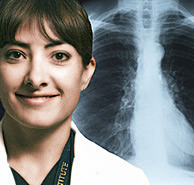RT job market tightens
by
Brendon Nafziger, DOTmed News Associate Editor | August 13, 2010

Fewer job openings.
The job market for radiologic technologists is tightening, with the lowest vacancy rate on record, according to the American Society of Radiologic Technologist's latest jobs survey; and more than half of radiology managers say they aren't hiring.
The dwindling job prospects are being driven partly by the increase in graduates of RT programs and employers worried about economic woes, the ASRT said.
The vacancy rate, or the number of positions unfilled, for radiographers is now 2.1 percent, meaning out of 100 budgeted full-time jobs, only about two aren't filled. That's almost one-fifth the rate seven years ago of 10.3 percent, and the lowest since the ASRT began collecting the jobs information in 2003.
The outlook is similar in other disciplines, with the vacancy rate for CT technologists falling from 8.5 percent in 2003 to 2.6 percent this year; MR techs falling from 9 percent to 3.4 percent; mammographers from 7.2 percent to 1.8 percent; nuclear med techs from 10.9 percent to 2.1 percent; and cardiovascular-intervention techs from 14.6 percent to 3.5 percent.
Sonographers had the best prospects, with a vacancy rate at 4.6 percent, though still down from 11.7 percent in 2003.
The jobs survey was answered by 1,654 respondents, all managers of radiology facilities in the United States. Overall, about 54 percent of them said they weren't hiring full-time workers, and about half said there was no recent turnover.
WATCHFUL WAITING
One of the forces behind the shrinking opportunities has been "a consistent number of RTs graduating from programs and entering the workforce over the past seven years," ASRT's Director of Research John Culbertson told DOTmed News by email.
"Another major factor is a collective 'wait and see' approach in terms of the economy and health care reform," he said. "Many imaging centers are waiting to recruit until the economy turns around."
Technologists delaying retirement to protect their income until the economy picks up again are also reducing the number of openings, Culbertson said.
A weakening job market is also having an effect on enrollment at radiologic technologist schools. Entering-class enrollment at RT programs has fallen each year since 2007, the ASRT said. "Enrollments typically decrease when staffing demand is low and increase when demand is high," the group said.
Bellevue Hospital Center, in New York City, said along with other schools it's voluntarily reducing enrollment this year.
"We've decreased our enrollment a little bit based on the job market," Peter Castagne, director of the rad tech program, told DOTmed News. "We don't want to put more graduates into a glutted job market."
Although Bellevue said it's seeing an increase in the number of inquiries about the school, it plans on cutting enrollment to 14 to 16 students in October, when classes begin, instead of the usual 20.
But for those graduates who want to get a job, head west: Mountain states, such as Idaho, Wyoming and Nevada, had the highest average vacancies, about 3.9 percent, three times higher than the weakest hiring region in the South, including Kentucky, Tennessee, Mississippi and Alabama.
And as for the future, ASRT said demographic changes, health care reform, reimbursement shifts and technological advances can all influence the RT job market.
"Time will tell whether or not this trend continues," Culbertson said.
